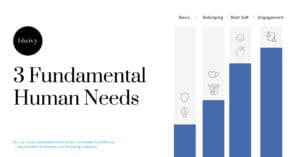An unprecedented year has challenged the world of business in almost every way. The digitization of the workplace has fundamentally reshaped the employee experience. From now on, how we foster a sense of connection and belonging throughout an organization will likely look very different. It is important to understand what has changed so that we can continue to optimize employee experiences in an authentic and meaningful way.
Employee Experience: the consistency and quality of interactions that an employee has with a company.
This can be shaped by the daily behaviours, leaders, communications, processes, technologies and policies that are in place. These interactions build on each other over time, and the sum of these moments make up the employee experience.
“Whether you’re just starting your Employer Brand journey, you’re well into it, or you consider your organization to be at expert level, there are always opportunities to improve because the world and the world of work continue to evolve.” – Nicole Fernandes, Director, Employer Brand & Culture I DEI Practice Lead, Blu Ivy
Employee expectations are evolving with the increasing detachment from the traditional workplace. Existing employees are facing new challenges as they continue to work from home – potentially permanently – and new employees – who have likely never met any of their colleagues face-to-face – need to feel that their needs are being met and be motivated to proactively engage within the organization.
To help navigate these changes, we have created a cheat sheet of fundamental workplace culture terminology:
Employee Engagement: The level of commitment, loyalty and enthusiasm among employees for their job and their employer.
Engagement positively correlated to powerful bottom line outcomes (motivation, satisfaction, productivity and intention to stay), but it is also a critical step in fully integrating a DEIB strategy.
An engaged workforce has an emotional connection to their work and is therefore intrinsically driven to perform and achieve top results. Employees are more likely to be engaged when their needs are being met, but those needs may look different now. Organizations need to recognize these changes and reevaluate best practices that will foster employee engagement.
Authenticity: The degree to which you can be or express your true self.
The ability to be authentic at work is a key motivator for employee performance, and the necessity for an upper management team that is authentically invested in the meaningful engagement of their employees is equally, if not more important.
Management who authentically stand behind the EVP and make efforts to put it into action enable employees to express their full authenticity. Therefore, an employee who believes that their authenticity is valued is more likely to invest themselves into the work that they do and, theoretically, produce compelling and meaningful work.
It is becoming increasingly important to approach DEIB strategy as a long-term investment at all levels of the organization. When we break it down – Diversity, Equity, Inclusion and Belonging – we see how the employee experience motivates an employee to be their best self and achieve their highest level of engagement:
Diversity: The psychological, physical and unique social differences that occur among any and all individuals.
When an organization embraces diversity, good things happen. Without the constraints of location, transportation and other similar factors of the traditional workplace commute; it is inevitable that organizations will see an even further diversification of the workforce.
However, while the digital workplace creates more equal opportunity at the hiring stage, employees are experiencing adverse impacts of diversity within the digital workplace, which may be further exacerbated in employees from underrepresented communities. In fact, a Mckinsey article states, “Diverse groups—including women, LGBTQ+ employees, people of color, but also working parents—are having the hardest time, both in the workplace and with balancing work and home life.”
Equity: The degree to which processes and programs are just, impartial, and fair for all individuals.
An equitable environment empowers employees to embrace diversity and engage in the workforce in a more meaningful way.
Since the pandemic began, employees have had less opportunities to engage in the support structures that once enhanced their sense of belonging. As the workplace transforms, organizations must find new ways to equalize accessibility and support employees in ways that address new workplace variables. Some variables to consider are decreasing onsite/physical attendance, a de-standardized 9-5 schedule, inconsistent WIFI connection, and so on.
Inclusion: The degree to which individuals (especially diverse and underrepresented groups) are able to participate fully within an organization or group.
Perceived inclusion is a key decision-making factor for prospective job applicants. It also enables new and current employees to excel in their roles and grow within the organization.
Barriers to inclusion are not new outcomes of the pandemic; in fact, we see increased challenges especially for women, people of colour (POC) and LGBTQ+ (McKinsey). For people of colour, working from home has already started to exacerbate existing issues with inclusion [in the tech spaces], and presents “an added barrier to inclusion within a virtual space” (NY Times).
Belonging: The feeling that individuals are welcome to bring their full perspectives and true selves to the table, and are accepted.
More than ever, “special effort needs to be placed on creating systems of belonging”. Employees need to be able to feel like they can be themselves, know that they belong, whether they choose to work in a traditional office or from home.
Without a common physical space, there is an exponential increase in the potential factors that may cause employees to feel unengaged, disconnected or even discriminated against. These systems must accommodate the inevitable variability of individualized and unregulated home workspaces which, for many, may become a permanent solution.
Employees – new and existing – are struggling to stay motivated and proactively engage within the organization as they continue to work from home. And, while for many there may be less barriers during the hiring process, new employees are at risk of getting left behind as they look for a sense of belonging amongst a group of colleagues who they have likely never met face-to-face.
A thoughtful and intentional DEIB strategy will make your employer brand stand out to an expanded audience of premium talent, but it will also ensure that they experience what they have been promised.
To learn more about how we can help you create a more effective employee experience for your organization, or for additional research insights or inquiries on how to build an award-winning employer brand, please contact Stacy Parker at sparker@bluivygroup.com.
About Us
Blu Ivy Group is a global leader in employer branding, organizational culture, and recruitment marketing. We help organizations across the private, public, and not-for-profit sectors build extraordinary employee experiences, magnetic employer brands and high-performance cultures.
From C-Suite to Employer Brand and Talent Acquisition leadership, we partner with our clients to transform their organizations and design the most compelling workplaces of the future.






